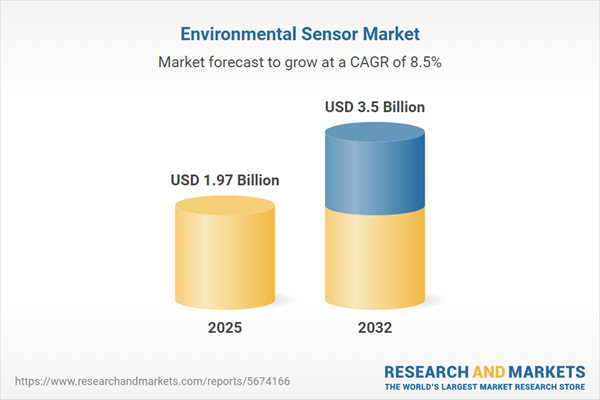Speak directly to the analyst to clarify any post sales queries you may have.
The environmental sensor market is undergoing rapid transformation, driven by ongoing digitalization, regulatory mandates, and growing demand for real-time environmental data across diverse sectors. As enterprises adapt to stricter standards and operational efficiency goals, these advanced sensing solutions are increasingly integrated into infrastructure and systems worldwide.
Market Snapshot: Growth Trajectory and Competitive Landscape
The environmental sensor market grew from USD 1.83 billion in 2024 to USD 1.97 billion in 2025. It is projected to reach USD 3.50 billion by 2032, representing a CAGR of 8.46%. Heightened focus on air quality, safety, sustainability, and regulatory compliance across industries, paired with advancements in sensing technology and analytics, is fueling this consistent expansion. Established companies, emerging startups, and collaborative ecosystems are all actively shaping the market’s competitive environment as they strive to deliver robust, innovative solutions tailored to an array of deployment scenarios and end users.
Scope & Segmentation of the Environmental Sensor Market
This comprehensive report analyzes vital market dimensions and technological advances that underpin the environmental sensor ecosystem, offering clarity for senior decision-makers. Key segments addressed include:
- Sensor Types: Air quality, gas, humidity, pressure, and temperature sensors each meeting distinct industry needs.
- Functional Capabilities: Detection, monitoring, and sensing technologies serving applications that range from threshold alerts to continuous data tracking.
- Connectivity: Wired sensors provide stable communication for industrial settings, while wireless devices offer deployment flexibility in both commercial and residential contexts.
- Deployment Models: Indoor and outdoor installations as well as portable solutions catering to spot checks and mobile fieldwork.
- Applications: Commercial, industrial, and residential facilities, leveraging sensor insights for energy optimization, safety, and comfort management.
- End-Use Industries: Aerospace, automotive, food and beverage, government and municipal services, retail, and utilities each present unique reliability and accuracy requirements for sensing technologies.
- Geographic Markets: Americas, Europe, Middle East, Africa, and Asia-Pacific regions, each with specific regulatory, economic, and adoption trends influencing growth potential and value creation.
- Technology Focus: Microelectromechanical systems (MEMS), nanomaterials, IoT integration, low-power wireless protocols, and edge computing advance overall market performance and solution capabilities.
Key Takeaways for Senior Decision-Makers
- Industry-wide investments in sensor miniaturization, energy efficiency, and analytics platforms are enabling more granular, real-time environmental data for enhanced operational decision-making.
- Technological maturity—including integration with IoT and edge computing—broadens deployment options and unlocks innovative business models not previously accessible to many organizations.
- Stringent regulations on emissions, indoor air quality, and industrial safety accentuate the necessity for reliable and compliant sensor infrastructures, especially in commercial and public sectors.
- Collaboration between sensor manufacturers, system integrators, and digital service providers accelerates adoption of advanced monitoring solutions, enabling rapid response to evolving compliance and performance objectives.
- Market entrants and leaders alike benefit from resilient supply chains and flexibility in sourcing strategies, gaining competitive advantage through agile risk mitigation and cost optimization.
Tariff Impact on Supply Chain Strategy
Recent United States tariff adjustments on semiconductor substrates, metallic alloys, and other critical materials have increased production costs for environmental sensors. Manufacturers are responding by diversifying suppliers, expanding local production, and engaging in cross-functional collaboration to optimize design and material usage. These adjustments emphasize the necessity for resilient and agile supply chain frameworks, which directly impact competitive positioning within the sensor industry.
Methodology & Data Sources
This report is anchored in a blend of primary research—including in-depth interviews with industry experts and targeted surveys of procurement leaders—and secondary research from technical literature and regulatory filings. Rigorous validation and peer review underpin the analytical depth, ensuring robust, actionable findings for market participants.
Why This Report Matters
- Supports strategic planning by clarifying market trends, segmentation, and region-specific drivers for the environmental sensor market.
- Facilitates risk management by highlighting supply chain adaptations and tariff impacts relevant to operational cost-savings.
- Enables competitive benchmarking through detailed company profiles and analysis of ongoing industry consolidation.
Conclusion
The environmental sensor market is evolving amid technological innovation, regulatory change, and diverse regional needs. Leaders who align with these shifts will capture new opportunities and sustain long-term growth.
Additional Product Information:
- Purchase of this report includes 1 year online access with quarterly updates.
- This report can be updated on request. Please contact our Customer Experience team using the Ask a Question widget on our website.
Table of Contents
3. Executive Summary
4. Market Overview
7. Cumulative Impact of Artificial Intelligence 2025
Companies Mentioned
The companies profiled in this Environmental Sensor market report include:- ABB Ltd.
- Aeroqual Limited
- Amphenol Corporation
- ams-OSRAM AG
- Comptus Inc.
- eLichens
- Ezurio
- Honeywell International, Inc.
- Hunan Rika Electronic Tech Co., Ltd.
- IST AG
- KEMET Electronics Corporation
- METER Group, Inc.
- Murata Manufacturing Co., Ltd.
- Nissin Electric Co., Ltd.
- NuWave Sensor Technology Limited
- NXP Semiconductors N.V.
- Omron Corporation
- Renesas Electronics Corporation
- Ricoh Company, Ltd
- RioT Technology Corp.
- Robert Bosch GmbH
- Samsara Inc.
- Schneider Electric SE
- Sensirion AG
- Siemens AG
- STMicroelectronics International N.V.
- TE Connectivity Ltd.
- Texas Instruments Incorporated
- Vaisala Oyj
- Verkada Inc.
- Vertiv Group Corp.
- Zebra Technologies Corporation
Table Information
| Report Attribute | Details |
|---|---|
| No. of Pages | 188 |
| Published | November 2025 |
| Forecast Period | 2025 - 2032 |
| Estimated Market Value ( USD | $ 1.97 Billion |
| Forecasted Market Value ( USD | $ 3.5 Billion |
| Compound Annual Growth Rate | 8.4% |
| Regions Covered | Global |
| No. of Companies Mentioned | 33 |









